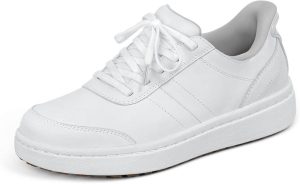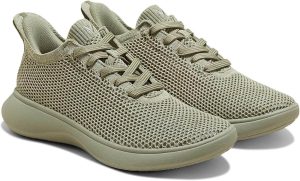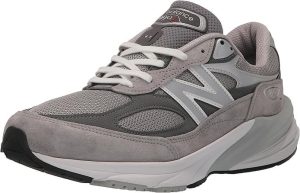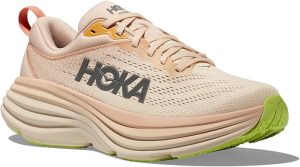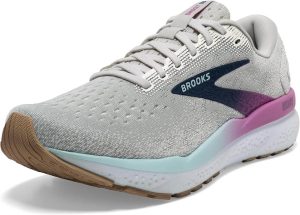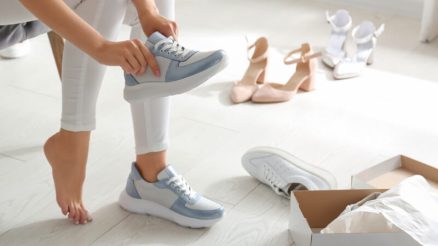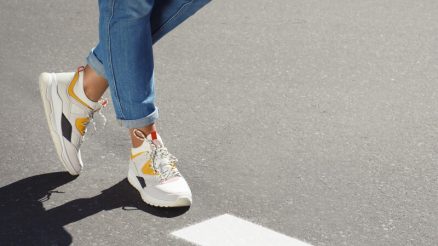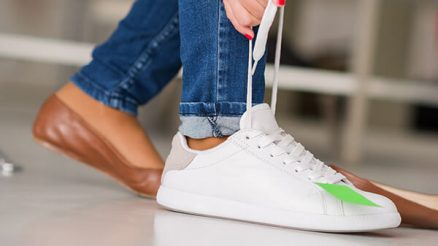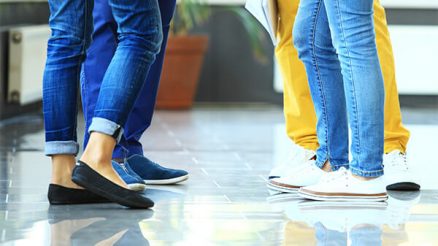Bunions can be painful and debilitating, making it essential to choose footwear that provides comfort and support. The right shoes can alleviate pressure, reduce pain, and prevent further progression of the condition. Here’s a comprehensive guide to selecting the best shoes for bunions, covering the features to prioritize and tips to ensure a proper fit.
🏆 Our Top Picks: Best Shoes for Bunions (2025)
After reviewing these top-rated shoes, here’s the final breakdown based on different priorities:
🥇 Best Overall for Bunions
🏆 Hoka Bondi 8 – Best for Maximum Cushioning & Pain Relief
🥈 Best for Everyday Comfort & Walking
🏆 Orthofeet Wander Casual Sneakers – Best Orthopedic Option
🥉 Best Stylish & Casual Pick
🏆 Vivaia Urban Sneaker Sliders – Best for Fashion + Comfort
Best Running Shoe for Bunions
🏆 Brooks Ghost 16 – Best Lightweight Running Shoe
Best Stability & Support Option
🏆 New Balance 990v6 – Best for Support & Durability
23 Best Shoes for Bunions in 2025
1. Orthofeet Women’s Wander Casual Sneakers
⭐ Rating: 4.8/5
Orthofeet is well-known for its orthopedic footwear, and the Wander Casual Sneakers live up to the reputation. These shoes feature a wide toe box, which allows your toes to spread naturally, reducing pressure on bunions. The arch support and cushioned insoles provide exceptional comfort, making them great for all-day wear. Additionally, the stretchable fabric prevents irritation and accommodates foot swelling.
Pros:
✔ Wide toe box for extra space
✔ Stretchable fabric prevents pressure points
✔ Cushioned insoles for comfort
Cons:
✖ Not the most stylish option
✖ Slightly pricey compared to regular sneakers
2. Vivaia Unisex Urban Sneaker Sliders
⭐ Rating: 4.6/5
Vivaia’s Urban Sneaker Sliders are a game-changer for those looking for both style and comfort. The knit upper is ultra-flexible, allowing your feet to move freely without restriction. The slip-on design is perfect for people with bunions, as it eliminates pressure from laces or tight-fitting shoes. While they don’t offer as much arch support as orthopedic shoes, they’re lightweight and breathable, making them a great choice for casual wear.
Pros:
✔ Stylish, modern design
✔ Lightweight and breathable
✔ No tight laces to cause discomfort
Cons:
✖ Less arch support than orthopedic brands
✖ Not ideal for high-impact activities
3. New Balance 990v6
⭐ Rating: 4.7/5
If you need a supportive walking or running shoe, the New Balance 990v6 is a fantastic choice. These shoes are roomy, well-cushioned, and durable, making them perfect for long walks, travel, or even daily errands. The mesh upper offers breathability, while the wide fit options ensure a bunion-friendly experience. Although they are a bit bulkier than other sneakers, their stability and support make them worth the investment.
Pros:
✔ Available in wide sizes for bunion relief
✔ Excellent support and cushioning
✔ Durable construction
Cons:
✖ Bulky design may not suit all preferences
✖ More expensive than similar models
4. Hoka Bondi 8
⭐ Rating: 4.9/5
For those seeking maximum cushioning, the Hoka Bondi 8 is the best option. These shoes are known for their plush, cloud-like midsoles, which make walking feel effortless. The rocker-style sole helps propel you forward, reducing foot fatigue. Their wide toe box and soft, breathable upper ensure no pressure on bunions, making them ideal for anyone with foot pain. If you’re looking for a walking or running shoe that feels like a pillow, this is it!
Pros:
✔ Superior cushioning for shock absorption
✔ Wide toe box for extra comfort
✔ Great for walking and running
Cons:
✖ May feel too soft for those who prefer firm support
✖ Higher price tag
5. Brooks Ghost 16
⭐ Rating: 4.7/5
The Brooks Ghost 16 is a fantastic choice for those who want a lightweight and responsive running shoe without sacrificing comfort. The DNA Loft cushioning provides soft yet supportive padding, making these shoes ideal for long runs or walks. They also offer a roomy toe box, which is perfect for reducing bunion pain. While they may not be as cushion-heavy as the Hoka Bondi 8, they strike a perfect balance between comfort and responsiveness.
Pros:
✔ Lightweight and well-cushioned
✔ Breathable mesh upper for airflow
✔ Good balance of support and flexibility
Cons:
✖ Not as wide as some orthopedic shoes
✖ Less cushioning than Hoka Bondi 8
Understanding Bunions
A bunion, medically known as hallux valgus, is a bony bump that forms on the joint at the base of the big toe. It’s a common condition, affecting millions of people worldwide, particularly women. It occurs when the big toe pushes against the adjacent toe, forcing the joint to enlarge and protrude. Symptoms include pain, swelling, and redness around the affected joint, which can worsen with ill-fitting shoes.
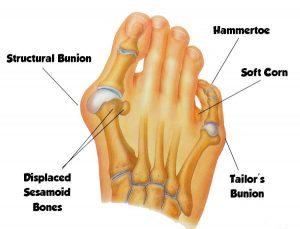
Key Features to Look For in Shoes for Bunions
- Wide Toe Box
- A roomy toe box prevents pressure on the bunion by giving your toes ample space to spread naturally. Look for shoes labeled as “wide” or “extra wide,” especially if you experience frequent discomfort.
- Soft and Stretchable Uppers
- Materials like leather, mesh, or knit fabric can stretch and conform to the shape of your foot, reducing friction and pressure on the bunion. Avoid stiff materials that may exacerbate irritation.
- Low or Moderate Heel Height
- High heels can force your toes into a cramped position, worsening bunion pain. Opt for shoes with a heel height of no more than 1 to 2 inches for better weight distribution and reduced stress on the forefoot.
- Arch Support
- Proper arch support helps maintain the foot’s natural alignment, preventing excessive pressure on the bunion area. Consider shoes with built-in arch support or use custom orthotic insoles.
- Cushioned Insole
- A cushioned insole provides shock absorption and reduces impact on the bunion. Memory foam or gel insoles are excellent choices for added comfort.
- Adjustable Features
- Shoes with adjustable straps, laces, or Velcro closures allow you to customize the fit, ensuring minimal pressure on sensitive areas.
- Lightweight and Flexible Soles
- Lightweight soles reduce foot fatigue, while flexibility ensures the shoe moves naturally with your foot. Look for soles made of rubber or EVA for durability and comfort.
Tips for Selecting the Right Shoes
- Measure Your Feet Regularly
-
Foot size can change over time due to various factors such as age, weight fluctuations, and foot conditions like bunions. These changes can affect the overall fit of your shoes, making it crucial to measure your feet regularly. Measure your feet annually and try on shoes in the late afternoon or evening when your feet are at their largest.
-
- Shop in Person When Possible
- Trying on shoes in-store allows you to assess their fit and comfort immediately. Walk around to ensure there’s no pinching or rubbing.
- Prioritize Comfort Over Style
- While fashionable shoes are tempting, prioritize function and comfort. Many brands now offer stylish options designed specifically for bunions.
- Break in Shoes Gradually
- Even the most comfortable shoes may require a short break-in period. Wear them for short durations initially to ensure they don’t cause discomfort.
Recommended Shoe Types for Bunions
- Athletic Shoes
- Brands like Brooks, New Balance, and Asics offer wide-width options with excellent cushioning and support.
- Orthopedic Shoes
-
Companies like Vionic, Orthofeet, and Hoka specialize in designing shoes for foot conditions, including bunions. These brands are known for incorporating features like enhanced arch support, cushioned insoles, and wider toe boxes, which help alleviate discomfort and provide superior foot alignment.
-
- Sandals with Adjustable Straps
- Look for sandals with multiple adjustable straps to avoid pressure on the bunion. Birkenstock and Teva are popular choices.
- Slip-On Shoes
- Ensure they have a stretchy upper and a snug but not tight fit. Skechers and Allbirds offer comfortable slip-on options.
When to See a Specialist
If bunion pain persists despite wearing appropriate footwear, consider consulting a podiatrist. They can recommend treatments such as custom orthotics, physical therapy, or, in severe cases, surgery.
Conclusion
Choosing the right shoes for bunions is a critical step in managing discomfort and protecting your foot health. Prioritize features like a wide toe box, soft uppers, proper arch support, and cushioning to ensure your shoes provide the comfort and support you need. By investing in well-designed footwear, you can reduce pain and enjoy greater mobility in your daily life.

